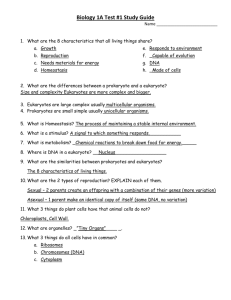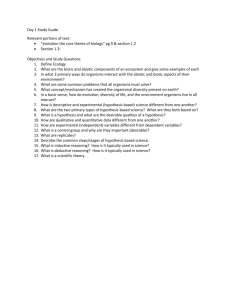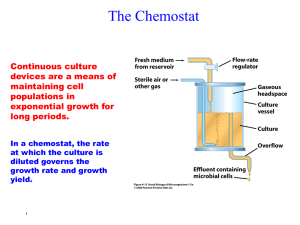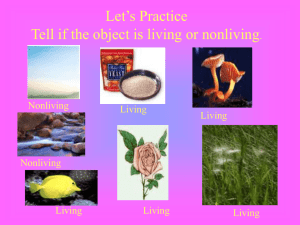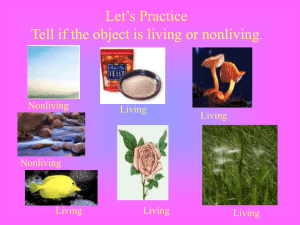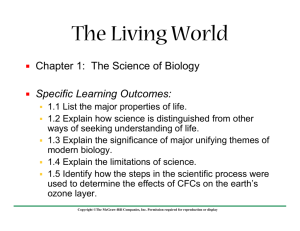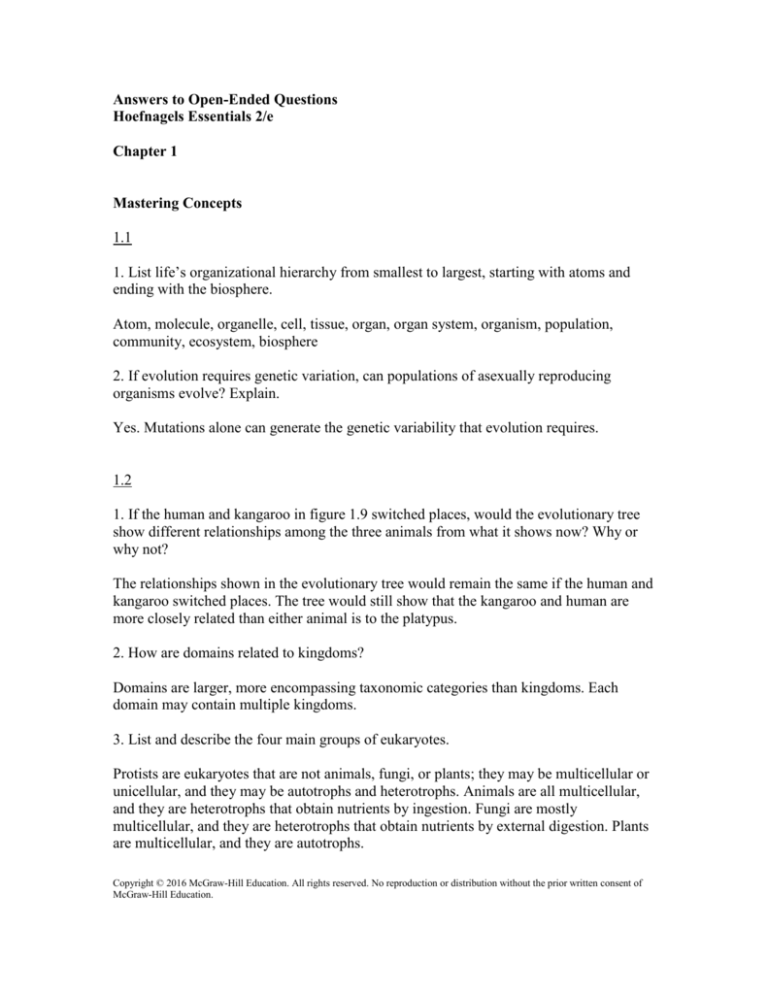
Answers to Open-Ended Questions
Hoefnagels Essentials 2/e
Chapter 1
Mastering Concepts
1.1
1. List life’s organizational hierarchy from smallest to largest, starting with atoms and
ending with the biosphere.
Atom, molecule, organelle, cell, tissue, organ, organ system, organism, population,
community, ecosystem, biosphere
2. If evolution requires genetic variation, can populations of asexually reproducing
organisms evolve? Explain.
Yes. Mutations alone can generate the genetic variability that evolution requires.
1.2
1. If the human and kangaroo in figure 1.9 switched places, would the evolutionary tree
show different relationships among the three animals from what it shows now? Why or
why not?
The relationships shown in the evolutionary tree would remain the same if the human and
kangaroo switched places. The tree would still show that the kangaroo and human are
more closely related than either animal is to the platypus.
2. How are domains related to kingdoms?
Domains are larger, more encompassing taxonomic categories than kingdoms. Each
domain may contain multiple kingdoms.
3. List and describe the four main groups of eukaryotes.
Protists are eukaryotes that are not animals, fungi, or plants; they may be multicellular or
unicellular, and they may be autotrophs and heterotrophs. Animals are all multicellular,
and they are heterotrophs that obtain nutrients by ingestion. Fungi are mostly
multicellular, and they are heterotrophs that obtain nutrients by external digestion. Plants
are multicellular, and they are autotrophs.
Copyright © 2016 McGraw-Hill Education. All rights reserved. No reproduction or distribution without the prior written consent of
McGraw-Hill Education.
1.3
1. Identify the elements of the experiment summarized in the Why We Care box on
page 13.
Independent variable = presence or absence of saccharin; dependent variable = incidence
of cancer (number of tumors); standardized variable = brand of chow; control group =
rats that did not receive saccharin; sample size = 100 rats per group
2. Why is statistical analysis important?
Statistical analysis helps researchers to determine the probability that changes in an
independent variable (and not chance) caused the measured effects on a dependent
variable.
3. What is the difference between a hypothesis and a theory, and why are some theories
regarded as facts?
Both hypotheses and theories are explanations for natural phenomena. However, a
hypothesis is not as widely accepted or as broad in scope as a theory. A theory is a
comprehensive explanation supported by multiple lines of evidence. Facts are repeatable,
undisputed observations; some theories, such as the theory of evolution, are so well
accepted that they are also considered facts.
4. What are some limitations of scientific inquiry?
Scientific inquiry cannot answer subjective questions related to beauty, morality, ethics,
religion, or any other subject for which it is impossible to develop testable hypotheses.
Other limitations include multiple plausible interpretations of certain experimental
results, and the human tendency to disregard results that are contrary to our preexisting
beliefs.
5. Compare and contrast science and technology.
Scientific discoveries enable people to develop new technologies, and new technologies
can help advance scientific knowledge. The goal of science is to explain phenomena that
can be observed in the natural world, and the goal of technology is to discover practical
uses for scientific knowledge.
Write It Out
1. Describe each of the five characteristics of life, and list several nonliving things that
possess at least two of these characteristics.
Copyright © 2016 McGraw-Hill Education. All rights reserved. No reproduction or distribution without the prior written consent of
McGraw-Hill Education.
(1) Life is organized, following a hierarchical pattern from atoms to the biosphere. (2)
Organisms acquire and use energy to build cells, repair damage, and reproduce. (3)
Organisms maintain homeostasis, so the interiors of cells and living organisms remain
within a constant range even if environmental conditions change. (4) Organisms
reproduce, meaning they produce offspring that grow and develop into adults that can
also reproduce. (5) Life evolves, which means that the genetic makeup of every
population changes from generation to generation.
The following are examples of nonliving things that possess at least two of life’s
characteristics: a house is structurally organized and maintains a constant range of
temperature; automobiles are organized and require energy; crystal formations are
organized and grow; viruses are organized and evolve. (Other answers are also possible.)
2. Draw and explain the relationships among producers, consumers, and decomposers.
Answers will be visual; see figure 1.4. Producers convert light energy and nutrients into a
form that consumers can also use. When organisms die, the decomposers release the
nutrients back into the soil to be taken up by the plants.
3. Describe the main differences between asexual and sexual reproduction. Should
changing or unchanging conditions favor each type of reproduction?
In asexual reproduction, all the genetic information comes from one parent, so organisms
are almost identical. In sexual reproduction the genetic information comes from two
parents, generating variation. Asexual reproduction produces the least genetic variation,
so it should be most adaptive in habitats that are stable. Sexual reproduction allows
populations to adapt to changing environmental conditions.
4. Why is a cell, and not an atom or a molecule, considered the basic unit of life?
A cell is the basic unit of life because it is the first level of organization that displays all
of the characteristics of life. Atoms and molecules do not have all five of life’s properties.
Furthermore, both living and nonliving things are composed of atoms and molecules, but
only living things are composed of cells.
5. Think of an analogy that will help you remember the differences between populations,
communities, and ecosystems.
Many analogies are possible. For example, a puzzle is analogous to a population; the
collection of the toys in the child’s room is analogous to a community; and the child’s
room is analogous to an ecosystem.
All of the pieces of the single puzzle represent individuals of the same species, which
make up a population. A puzzle is just one of many types of toys in a child’s room, just
as many populations make up a community. All of the objects in the child’s room,
Copyright © 2016 McGraw-Hill Education. All rights reserved. No reproduction or distribution without the prior written consent of
McGraw-Hill Education.
including the toys, furniture, carpet, and air, represent the living and nonliving
components of an ecosystem.
6. Other than the brownie example given in the text, name an example of emergent
properties from everyday life.
Examples could include anything that incorporates the interactions among multiple
simpler parts, such as bricks and mortar coming together to make a house, or a large tub
of water creating a swimming pool.
7. How are the members of the three domains similar? How are they different?
The members of all three domains are made of at least one cell and contain DNA.
Domains Bacteria and Archaea are superficially similar; both consist of prokaryotes and
are typically unicellular. However, DNA sequences differ between bacteria and archaea.
Domain Eukarya consists of organisms with eukaryotic cells, which have a nucleus.
8. Give two examples of questions that you cannot answer using the scientific method.
Explain your reason for choosing each example.
Science cannot answer questions regarding moral, ethical, aesthetic, and religious issues.
Two examples of questions that science cannot answer are “Is a rattlesnake or a peacock
more beautiful?” and “Is it wrong to use animals in cosmetics research?” The former is a
question of aesthetics and taste, and the latter is a question of ethics.
9. If you dissect and label the parts of an earthworm, are you “doing science”? Why or
why not? Give an example of a testable hypothesis that could result from dissecting
organisms.
The act of dissecting and identifying the parts of an earthworm is observational, and it
provides investigators with the anatomical knowledge needed to ask questions and
develop hypotheses. A testable hypothesis resulting from such an activity could address
the relationship between the size of an earthworm and the number of segments.
10. List each step of the scientific method and explain why it is important.
First, a scientist must observe a phenomenon and question how it works. Without this
curiosity, much of what we know about the natural world would never have been
discovered. Next, a scientist must use what he or she already knows to form a hypothesis,
which is a tentative explanation. This is important because it is a testable statement that
should help answer the question. The prediction that follows from the hypothesis
specifies which results will support or refute the hypothesis. The scientist can then collect
data by further observation or experimentation. This step is crucial because it provides
the information required to test the hypothesis. The resulting data, when integrated with
prior knowledge, leads the scientist to conclude whether or not the hypothesis should be
Copyright © 2016 McGraw-Hill Education. All rights reserved. No reproduction or distribution without the prior written consent of
McGraw-Hill Education.
rejected. Finally peer review ensures that other knowledgeable scientists have evaluated
the data before publication in a scientific journal.
11. Design an experiment to test the following hypothesis: “Eating chocolate causes zits.”
Include sample size, independent variable, dependent variable, the most important
variables to standardize, and an experimental control.
Overall, the experiment would require dividing a population into two groups, only one of
which receives chocolate. Before, during, and after the experiment, the researchers
would measure the density of pimples in each group. The independent variable in this
experiment is presence or absence of chocolate, and the dependent variable is the density
of zits. The experiment should include a large sample size (hundreds of people at
minimum). Some variables to standardize include other components of the diet, the age
group of the subjects, and the subjects’ history of skin problems. The control group
would consist of individuals not consuming chocolate.
Pull It Together
1. What are the elements of a controlled experiment?
A controlled experiment consists of a control group and one or more experimental
groups. The simplest experiments have only one difference between the groups; this
difference is the independent variable. The control group is one that is considered
“normal” for the variable being tested. It could be a healthy population compared to a
diseased population or it could be a population receiving no treatment compared to a
population receiving treatment. The dependent variable is the response that the
investigator measures. Standardized variables are factors that are the same for all
subjects, including the treatment and control groups.
2. What is the relationship between natural selection and evolution?
Natural selection is one of several mechanisms of evolution. For example, certain
members of a population might be more likely to reproduce than others because they are
stronger, better able to survive environmental stress, more efficient at finding resources,
or better at avoiding predation. Because they have greater reproductive success, their
adaptations become more common in the next generation of offspring.
3. Give an example of each of the five properties of life.
Many answers are possible; here are some examples. Organization: A deer dies after
being hit by a car because the force of the accident has disrupted the connections among
its organ systems. Energy: A kitten extracts energy from its mother’s milk. Homeostasis:
A dog’s panting helps the animal get rid of excess heat. Reproduction and development:
An oak tree produces acorns, which germinate and grow into mature oak trees. Evolution:
Copyright © 2016 McGraw-Hill Education. All rights reserved. No reproduction or distribution without the prior written consent of
McGraw-Hill Education.
Random mutations cause changes in the shape of fins, enabling fish to exploit new
resources in shallow water.
Copyright © 2016 McGraw-Hill Education. All rights reserved. No reproduction or distribution without the prior written consent of
McGraw-Hill Education.

